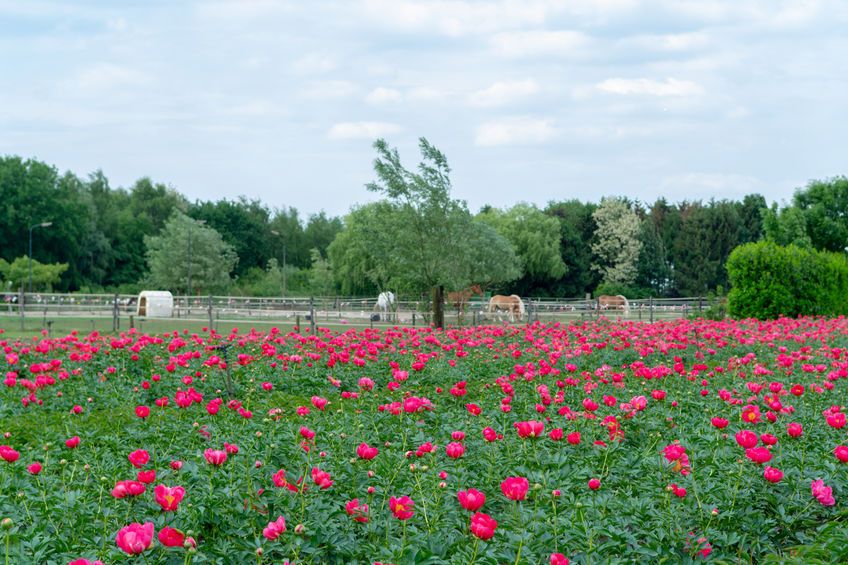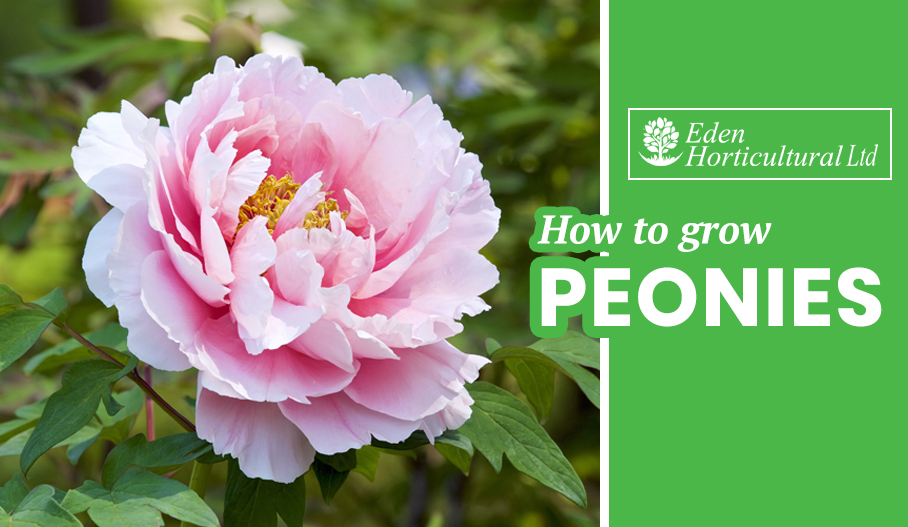For those unfamiliar with Peonies, they are perennial bushes that offer exuberant flowers in a wide range of colours on an annual basis. The flowers are big, fluffy, and vibrant, bringing colour and a sense of drama to your garden. This is probably why they have been such prominent and popular features in gardens throughout the centuries. They originate in Asia and date back to around 1000BC when they were used extensively in Chinese gardens.
Due to their robust nature and stunning presence, Peony plants are now a favourite of cultivators and gardeners worldwide. They are an excellent low-maintenance flowering plant or tree that blooms every spring without fail. But however easy to look after; it is important to choose the right type of plant for your garden and to plant it in the right way initially, for best results.
These beautiful flowering plants and trees can live for well over 50 years once they are settled, but settling them is the trick. If you plant your Peonies in quality nutrient-rich soil, away from competing roots and at an appropriate depth, it’s unlikely you will have to do anything else to cultivate your tree or plant. Of course, you can debud for bigger flowers in the spring, but otherwise, simply enjoy it and watch it grow.
The Basics of Peonies
There are three broad types of Peonies. These include: tree peonies, herbaceous peonies, and Itoh peonies. Tree Peonies are native to China; they are woody shrubs with stems that stay above ground all year. In summer, they have deep green foliage, and in autumn, they become bronze and purple.
Herbaceous Peonies are resilient flowering plants that can flourish in the same spot for over 50 years. They are low maintenance, require very little water, and are naturally resistant to most pests. The Itoh Peonies are the perfect blend of tree and herbaceous Peonies. They are both sturdy and produce beautiful flowers in a range of colours. They are perfect on the borders as they are shorter than their counterparts.
The three types of Peonies are similar, but they do have some notable characteristics that set them apart. In terms of height, the herbaceous and Itoh varieties grow between 1 to 3 feet tall and provide a similar spread; but the tree Peony can grow between 4 and 7 feet tall and spread 4 to 5 feet wide.
The majority of Peony plants are resilient and sun-loving, this includes all the types in the Herbaceous and Itoh categories, but the Tree Peonies don’t like prolonged direct sunlight. In this situation, the flowers will quickly die in only two or three days. If protected, however, they can last for up to 14 days. In China, it’s common practice to use parasols to protect these trees at certain times of the year.
Peony plants are generally quite resilient. In the right conditions, they can last for over 50 years with very little water or maintenance. They also have robust stalks that are resistant to deer and rabbits. While most garden pests will not affect your Peony plant, it is at risk from a certain fungus called botrytis blight. This disease can cause young shoots to rot and prevent flowers from developing. Look out for unsightly spots on the leaves.
Planting Peonies

In most places, peony flowers will bloom in April, May, or June. The first boomers are Tree Peonies, flowed by herbaceous varieties, and then intersections. It’s best to plant bare-root peonies in the fall – prior to the first frost for best results. This will give them a strong chance of blooming the following spring. If you plant tour bare-root peonies in the spring, they may not bloom for up to two years.
To ensure the long-term health and success of your Peopy plant, you must choose the right location for planting. Peony plants have deep roots that don’t enjoy competition, so planting them far from trees and bushes is recommended. They also have deep roots and don’t like wet feet. For this reason, it’s best to situate your Peony plant on slopes and raised beds to provide excellent drainage.
Peonies are known to do well in their native soil, and some gardeners trust this method for cultivating them. However, experts recommend combining the native soil with some high-quality organic matter; this will significantly improve the growth rate and health or your Peony plant. Furthermore, if you prepare the soil in this way, it will mean that your plant will not require fertilizers for the first few years; regardless of how you choose to prepare your soil, you must ensure adequate drainage, soggy roots will not do well.
It’s also possible to grow your peony plant in a pot, and some cultivators like to do this. It means the plant can be grown to particular dimensions and enjoyed indoors. If you intend to do this, select a large container with plenty of drainage holes. Bring your plant indoors for the winter to protect it from freezing temperatures and water it regularly. As pots dry out more quickly than soil, you will also have to maintain a frequent watering schedule.
How deep to Plant a Peony
The ideal depth to plant your Peony will largely depend on Peony’s tyle being planted and the type of soil you are planting in. Herbaceous peonies are typically sold as root clumps that grow into green-stemmed flowers. Tree Peonies will have a wooden stem attached to the root clump that will develop into a wooden stemmed shrub. In general, the planting advice for all people is consistent; however, the depth of planting is an important variation depending on your peony type.
Herbaceous Peonies, green-stemmed flowering plants, need to be planted on their own away from competitive roots, and in soil that can be well-drained. They grow best when the top bud is planted at a depth of 2 inches or 5 cm deep. Position your Herbaceous Peony with their eyes – that is next year’s buds – half an inch below the surface in warmer soil to two inches below the surface in cooler zones.
Not all organic soil is excellent for planting Peonies, even if they are resilient plants. In order to enrich your soil before planting, dig a hole that’s and 12-18 inches deep and the same distance wide. Your Tree Peonies will not have to be planted this deep, but it’s a good idea to prepare the soil underneath so that it’s fertile with suitable drainage. Before planting your Tree Peony – 4-8 inches down with the stem’s tip above the soil – add high-quality organic fertilizer to give the roots and early boost.
For Intersectional Peonies, that is, hybrid plants that cross between Herbaceous and Tree – planting them not far below the surface is best practice. This means only ½ an inch in warmer zones and 1.5 inches in cooler soil. As with the other Peonie types preparing the soil prior to planting is highly recommended for best results.
PEONY Aftercare and Pruning
After planting your Peony in the fall before the first frost, you should start to see it flower in the spring around six months later. When your Peony starts to blossom, it’s time to look after it with pruning and aftercare. Peonies do not require special routine attention like Rose bushes do, but they need occasional pruning to maintain optimal growth and protect the plant from damage and disease.
Herbaceous Peonies should be cut all the way to the ground at the end of the growing season. At this time, it’s also best to cut Intersectionals but leave 4 to 6 inches of stem. For Tree Peonies, remove suckers from the shrub’s centre every five years to allow better air circulation. Without this attention, the tree may be slow to grow, and you may risk losing it in the long run. Don’t prune your Tree Peonie within the first two or three years to encourage its early growth.
There are a variety of ways to cultivate your Peony to develop particular types of flowers. If you debud around the stalk, for instance, you will develop larger, more full, blossoms; but if you want to prolong the blooming season, simply leave the buds to grow. Peonies do not require dividing to produce excellent blooming, but this can be done as a form of propagation. The most optimal time for dividing is in the fall, using roots cut into pieces with three to five eyes.
Peony plants are very robust and typically do not require much maintenance, but some situations need to be considered for cultivators. If your Peonie plants do not bloom, it could be down to several factors. These include the roots planted too deeply or in the wrong soil type, not enough sunlight, or a saturated subsoil. If a Peony is unhappy, it may express this with leaf curl. It is a sign the plant may need water or have too much, or perhaps the indication of a virus or disease.


